Chapter 2
How to conduct user interviews: 6-Step process to actionable insights
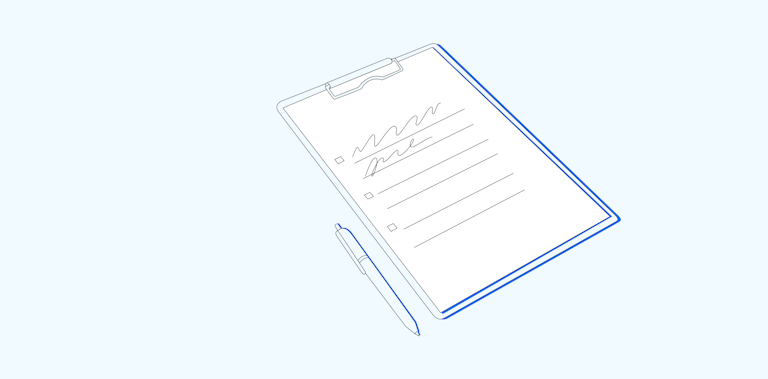
It’s time to sit down and listen up to what users have to say about your product.
Now that you’ve made the decision to run user interviews, there’s likely one big question on your mind: how can you conduct user interviews in a way that guarantees the in-depth insights you need?
While interviews may seem like sitting down for a chat, there’s more to this UX research method than meets the eye. Pushing beyond a simple conversation can garner rich, descriptive feedback to inform practical UX decisions.
In this chapter, we’ll share the user interview process via six key steps to ensure you’re making the most of your users’ time and responses. We’ll also cover some industry best practices to elicit the most valuable, actionable responses from your participants.
How to conduct user interviews: The full process
Interviewing users is a lot like ice skating—it looks easy, but requires careful planning, practice, and balance.
From recruiting the right participants, preparing interview questions, navigating the conversation, and, perhaps most importantly, analyzing the responses, conducting interviews is a detailed process.
We’ve outlined the six key steps on how to structure user interviews to help you get the insights you need from your user interviews.
1. Set your goals
Start by defining what you want to achieve from this research process. Are you launching a product and want to understand user expectations? Are you validating a new functionality or feature for your product? Are you collecting customer feedback to optimize the user onboarding experience?
These research objectives will guide your research in the right direction and ensure everyone’s on the same page. What’s more, all other aspects of planning this research—like the type of users you interview and the questions you ask—are closely tied to your objectives.
Hillary Omitogun, UX Research Consultant and Founder of HerSynergy Tribe, shares how she prepares for user interviews:
“I always start with a research plan. This has clear goals that align with the business's north star. I also create an interview guide. This includes questions I plan to ask, which are typically gathered from myself and team members, like a PM or designer. It also outlines how many people I'll be interviewing and who they are.”
Let’s look at a quick example of a good research goal:
Imagine you're building an AI-powered design tool to simplify and accelerate the UX design process. You want to test your assumptions about user behavior and refine your foundational ideas for this app with user interviews. So, the objectives of your user research process will be to identify:
- The shortcomings of current design tools
- Primary use cases for AI-powered design features
- Users’ expectations from an AI design solution
With goals like these, you’re looking at holding semi-structured, generative user interviews to find out more about user experiences and expectations.
💡 Head to Chapter 1 to learn more about the different types of user interview and which is right for your research project.
2. Prepare your interview questions
Once you're clear on the research project's purpose, you can start outlining your interview scenario. This will include a basic script for how you want an interview to pan out. Divide this plan into segments for every theme or topic you want to cover.
Coming up with the right research questions involves a lot of effort, and your first set of questions likely won’t be the same as the questions you ask your last interviewee. You have to constantly refine the questions based on people's responses to get valuable insights, so consider question creation a continuous effort.
Haley Stracher, Design Director and CEO of Iris Design Collaborative, notes what to be wary of when you’re drafting user interview questions:
“Avoid asking leading questions at all costs. I use a lot of unbiased and open-ended questions like ‘how did this feel to you?’, instead of ‘did you like this process?’ This will get you the best data you’re looking for and avoid any cognitive biases creeping in.”
✨ Not sure where to start with user interview questions?
Check out the Maze Question Bank for over 350 ready-to-go research questions, tried and tested by our own research team.
3. Recruit participants for your user research
When you’ve done this initial legwork, it’s time to find the right candidates for your interviews. Before you start searching and recruiting research participants, study your target audience and create ideal user personas for your product.
These fictional personas will tell you the characteristics to look for when shortlisting candidates. They'll also help in filtering out those who don't fit the bill, saving you the effort of interviewing the wrong users.
You can also go back to your goals and define the types of target users you want to interview. For example, if you want to introduce your product to a new market, you can interview prospective customers who fit your personas to understand their expectations for your product. However, if your goal is to assess the effectiveness of your self-serve support setup, then you have to talk to your existing users.
Here's the tricky part: finding the right users that match your defined personas. There are many ways to recruit participants for UX research, including:
- Spreading the word in relevant communities with project details and incentives
- Amplifying the message on social media channels and among your network
- Leveraging guerilla testing tactics to approach your target audience
- Checking out participant databases or working with recruitment agencies
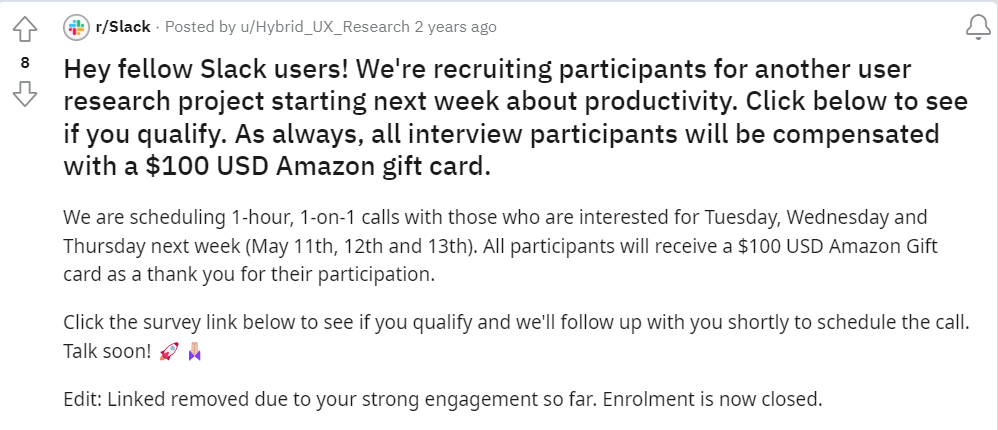
An example post calling for research participants
And if you're already using Maze, or considering making the switch, Maze Panel simplifies the entire recruitment process. Access a global panel of over 3 million participants in over 130 countries with our direct integration with Respondent, so you can quickly find qualified testers, no matter what you’re testing.
Over 400 filters and customizable screener questions allow you to narrow down participants based on specific criteria–plus, manual selection allows you to handpick participants from those who complete your screeners–ensuring you’re always speaking to the right audience.
Alternatively, you can recruit from your own community using direct links or in-product prompts with Maze Reach. You can analyze individual profiles, create and send custom recruitment campaigns, making your participant recruitment process a breeze.
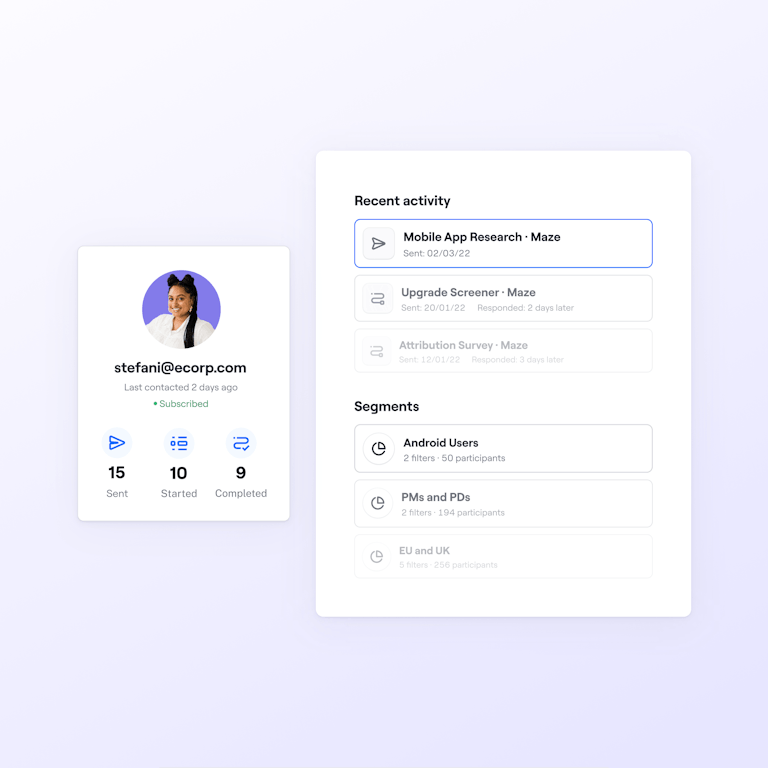
Once you’ve found your participants, you need to schedule your interviews. Maze integrates with popular calendar tools like Google Calendar and Office 365, so you can sync your availability.
You can customize session durations, set up meeting buffers, and even send automated email reminders to participants, helping to reduce no-shows. Everything is handled automatically, freeing you from the back-and-forth of manual coordination.
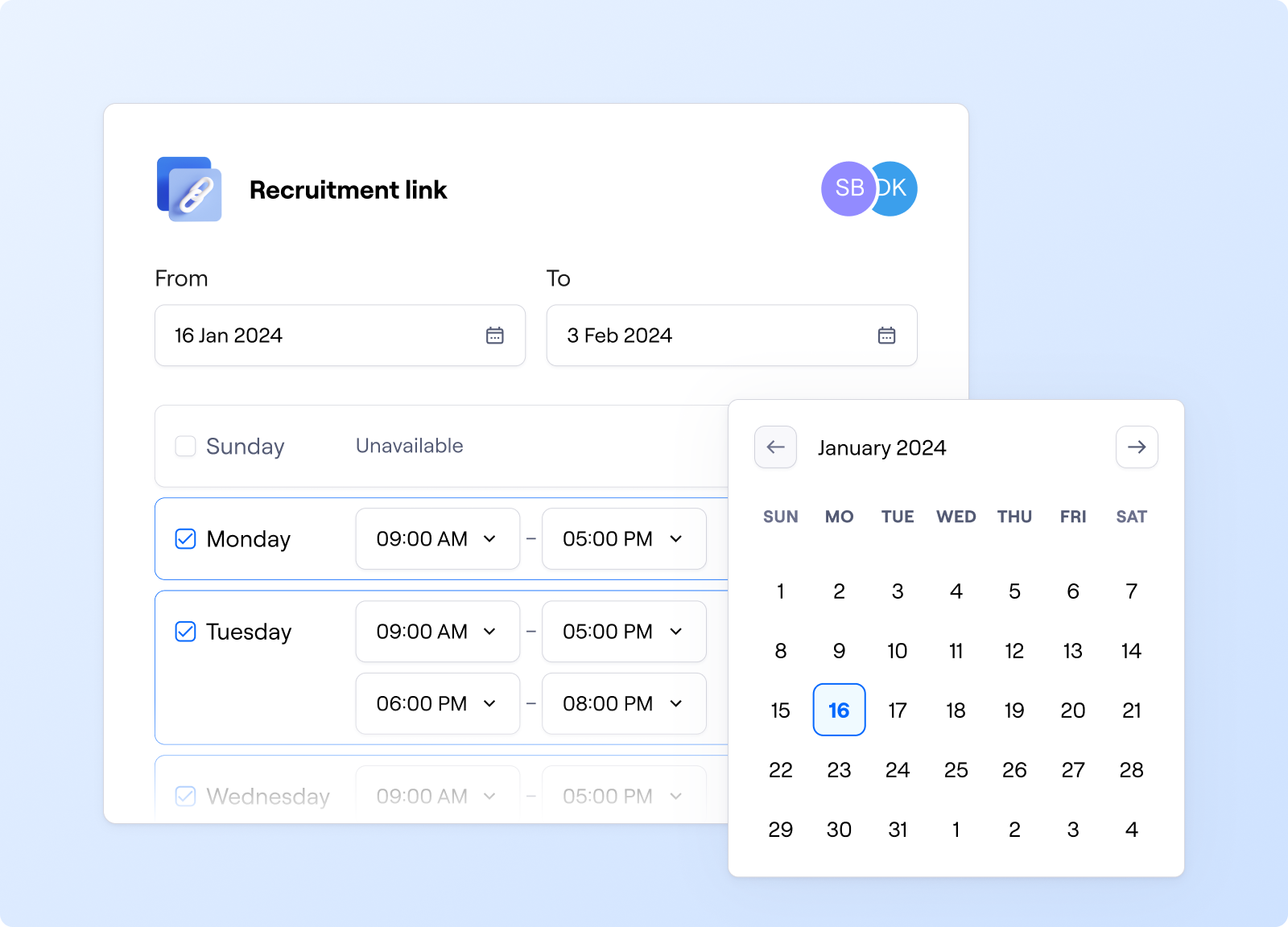
4. Introductions and build rapport
Before conducting your interviews, ask participants to fill out a research consent form. UX research ethics and best practices require informed consent to ensure participants have a complete understanding of their role in the study, its expected outcomes, and how their contributions will be used.
Once you’ve taken this written consent, you can start the interview by introducing yourself and sharing more context about the conversation.
Without delving into too much detail, briefly explain what the interview is for and your role in this project. Then, start with some lighter questions to learn more about each participant before moving on to your main points.
Pay attention to your body language, whether it's an in-person interview or a remote one. Your actions can make a huge difference in the interviewee's comfort and confidence. Consider these pointers when chatting with interviewees:
- Open with a smile and shake hands with interviewees (if in person, of course)
- Call interviewees by their names to build a connection
- Share some info on yourself to put them at ease e.g. your job role
- Be mindful of your body language and how it influences their perception of you
Overall, you want to maintain relaxed eye contact, nod frequently, and use empathetic, person-centered language.
5. Conduct the interview
This is what you’ve been working toward—it’s interview time. Both you and your participant should be ready to move into the interview stage after some introductions and chit chat.
Switching from small talk to the interview should be seamless—you don’t want participants to suddenly feel like they’re under pressure.
Ease into the interview; it’s even worth considering whether there’s a way you can link your first question to some expected small talk. This way, you know you’re consciously transitioning into the interview, but the interviewee feels it’s a natural progression of the conversation.
How your interview will pan out depends on the type of interview you’re conducting. If it’s structured you’ll likely rattle through the questions one at a time, but if it’s unstructured it’ll feel more like an open conversation. If it’s semi-structured, you’ll find yourself somewhere between these two.
Before starting, I make it a point to set clear expectations and answer any questions the participants might have.
Hillary Omitogun
UX Research Consultant
Share
It’s a good idea to keep your interview goals front and center when conducting interviews. You can’t get interview moments back—and you don’t want to find yourself wishing you’d asked an insight-packed follow-up question once you’ve completed the interview.
As with the introductions, keep your body language and tone positive and open. Keep participants engaged by using their name from time to time, and try to keep the interview as conversational as possible.
With Maze, you can launch the session directly through Interview Studies. It comes with built-in video conferencing powered by Zoom, so there’s no need for extra software or plugins. Prefer Google Meet or Microsoft Teams? Those are supported, too. You can also assign roles to team members—Moderator, Note Taker, Observer—so everyone knows their place and the session stays on track.
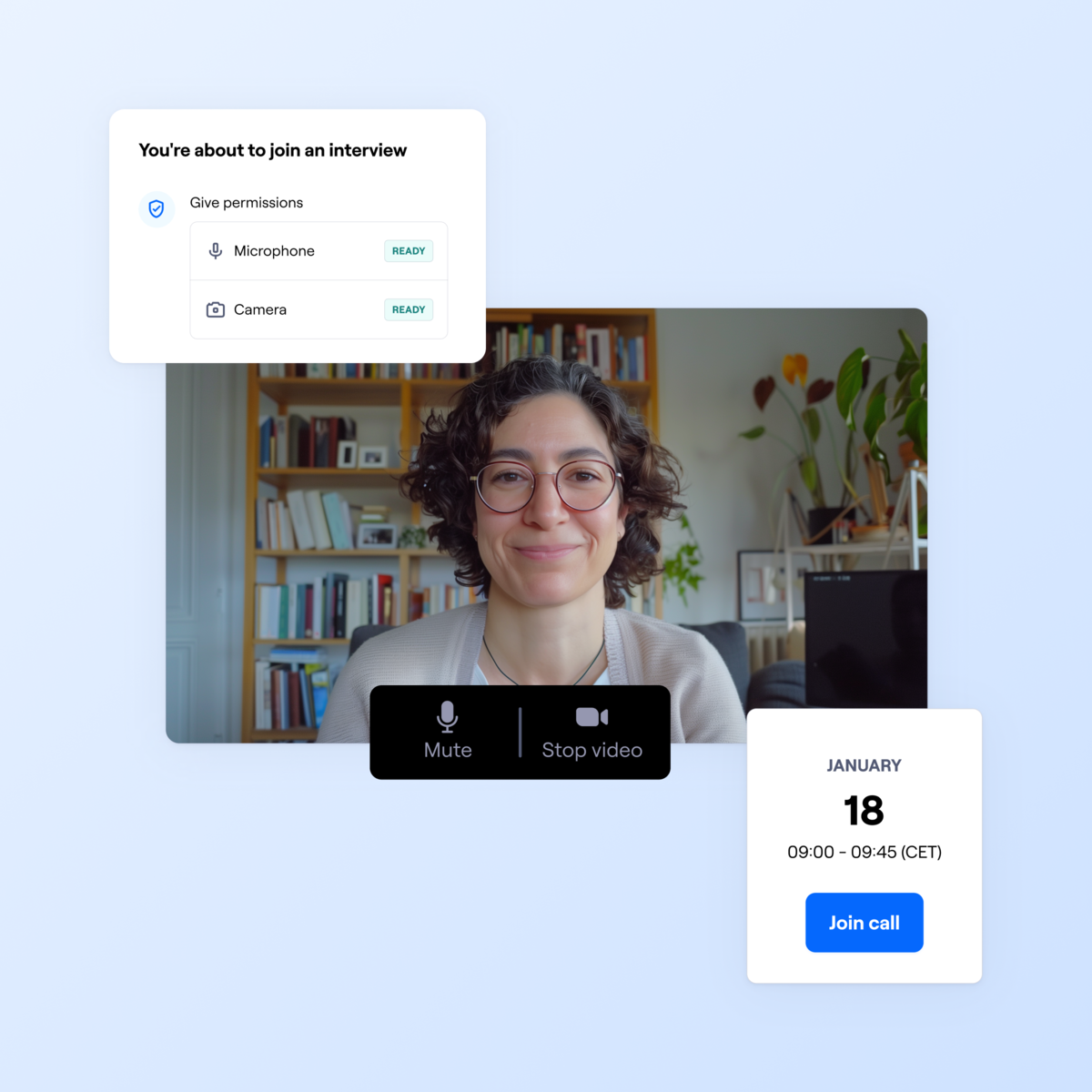
🛑 Remember to hit record
Taking notes is a great way to ensure you don’t miss anything throughout the interview, but don’t overdo it—you don’t want interviewees to feel like they’re under a microscope, and getting too stuck on notetaking can mean you lose rapport or miss important follow-up questions.
Recording your interview is an easy way to keep track of everything that’s been said, and allows you to be present in the moment, before going over the participant’s answers with a fine-tooth comb after the interview. It also means you have a permanent record of the interview, can share it with colleagues, and can use user interview tools to speed up analysis.
Alternatively, if you prefer pen and paper, Hillary suggests inviting a colleague to take notes during the interview: “In the past, I’ve had a PM or designer join user interviews to help take notes. I have a note-taking guide and template I share ahead of time—note-taking isn’t as simple as just relaying what the user said in the interview.”
💡 What’s next?
We cover user interview analysis in Chapter Four—jump ahead to learn how you can turn your user interview data into actionable insights.
6. Wrapping up
As a final step, debrief participants about the interview and thank them for participating. You can also encourage them to ask any follow-up questions about the project or get additional information.
This is also a good time to confirm the participant’s continued consent. Although they gave it at the start, they now know the full context of the interview and are in a better position to give complete, informed consent.
You should also discuss the next steps at this stage—like the incentive you promised or the project timeline. This quick debriefing round aims to keep them informed about the study and end on a positive note.
If you want to build a long-term connection with participants, it’s worth setting up a system to manage those relationships. With Maze Reach, you can create a centralized database of participants, organize them into dynamic segments, and easily invite them to future studies. Instead of starting from scratch each time, you’ll have an engaged, research-ready community at your fingertips, making every round of research faster and more efficient.
Moderated research has never been so easy
Simplify your interview workflow from start to finish with automated scheduling, seamless video sessions, and Al-driven analysis and reporting.
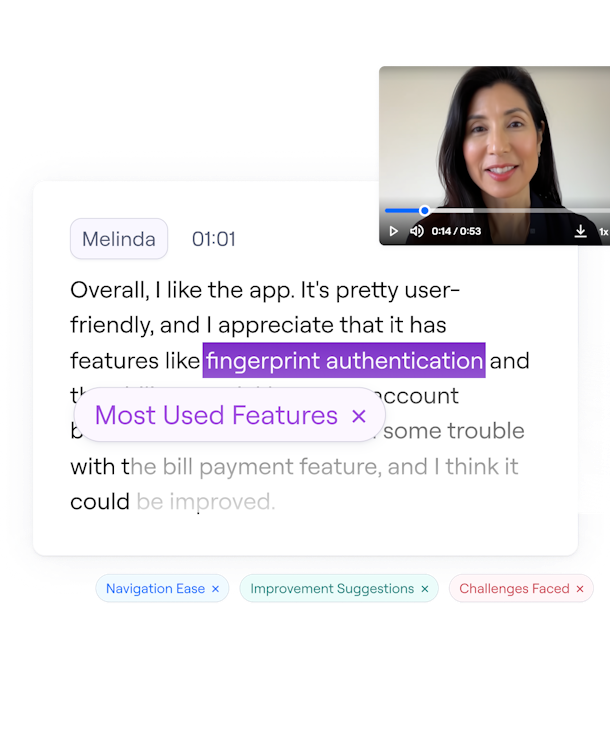
Best practices for conducting user interviews in UX research
The steps above are how you conduct user interviews, but running user interviews isn’t just about going through the motions—you’ll need to work within a framework of UX interview best practices to ensure you’re getting quality insights.
Think of the six steps to conduct user interviews as the seeds you plant, and these six best practices as the fertilizer sprinkled on top to enhance growth and make sure those plants are as vibrant as possible!
Here’s how to fertilize your user interviews to ensure they produce the in-depth, focused customer insights you’re looking for.
Get consent
Getting participants' consent is non-negotiable in UX research interviews. This written consent has a twofold purpose: first, it informs users of what they're interviewing for and how their data will be used, and secondly, it ensures researcher accountability when it comes to protecting participants.
Researchers of any kind have a duty to protect research participants from any type of psychological or physical harm. During user interviews, you’re held to the same ethical standards as any other researcher; obtaining informed consent is a key step in the user interview process.
Prepare, prepare, prepare
Nobody wants user interviews to fall flat—it’s a time and energy investment for both researchers and participants. Whether it’s clear notes to yourself, pre-prepared user interview questions or visual aids, ensuring you’re fully prepared is crucial for conducting successful user interviews.
One example is focusing your interview around journey flow. Journey flows are visualizations of a process users go through in order to complete a task with your product, service, or platform. Angling your user interview around a journey flow provides structure to the interview, and helps you pinpoint each decision a user makes from initial product contact to feature interactions.
Respect your user’s time
Interviews require considerable time and effort from both sides. Even after participants have agreed to the interview, make sure to confirm specifics like the topic of the interview, where it will be hosted (online or in-person), the expected time commitment, interview process, and any other details.
This does two things:
- It makes your interviewee feel respected and at ease, increasing the honesty and openness of their answers
- It increases the chance of your interviewee participating in follow-ups and future UX research projects
Make your interviewee comfortable
A good way to elicit authentic responses is to make users feel relaxed during the interview. Instead of hosting the session as a strict interview, carry it out like a relaxed conversation. Acknowledge user responses to help them feel confident and comfortable. Interviews can put participants under pressure—do your best to put them at ease.
That being said, Hillary highlights balancing warmth with remaining impartial:
“At the start of my career, I tried to be friendly by offering positive feedback like 'Oh, good information.' I realized this could unintentionally lead or bias the participants' responses, encouraging them to just repeat what they think I want to hear.”
Watch participant body language
While a user will be verbally answering your questions, be sure to pay close attention to subtle cues they communicate through body language. You want to understand what users do, not just what they say.
Reading body language complements verbal responses, giving you a clearer picture of your interviewee’s experience. It helps you identify the emotions that accompany the user's answers and gauge how comfortable or receptive they are during the interviews.
Here are a few body language signs, and what they can mean:
- Averted eye contact: Indicates your interviewee feels bored, deceived, or uninterested
- Raised eyebrows: usually reflects a state of surprise, uncertainty, or fear
- Mirroring: If a interviewee mimics your body language, it's a sign of rapport and agreement, indicating the interviewee is comfortable and engaged
⚠️ Read social cues with caution
Being mindful of nonverbal cues is helpful but it's crucial not to overestimate them. Our stereotypical understanding of body language doesn’t take into account neurodiversity, cultural differences, or even simple nerves.
For example, many neurodivergent people may avoid direct eye contact or fidget, but this doesn’t mean they’re not listening or feel bored. An anxious user may stutter their words, but it’s not a reflection of their feelings about the product.
Offer incentives to participants
For many UX teams, preparing a questions list and conducting a user interview won’t be the most challenging part of the process—the challenge will be recruiting the right participants for the job. Offering an incentive will entice and encourage users to partake in your interview process.
When choosing a reward for users, consider the complexity of your interview and participant demographics. A 30-minute interview on general customer feedback won’t warrant the same reward for an hour-long stint, delving into in-depth usability issues.
Some incentives to choose from include online vouchers, product discounts, exclusive access to new features, or a free trial for a paid plan.
Avoid leading questions
Leading questions guide your interviewees toward specific answers through suggestive question phrasing. This leads to inaccurate insights and unsuccessful user interviews.
We’re talking more about this in the next chapter of this guide, which focuses on writing user interview questions that get insights. However, we couldn’t fail to mention it here—as it’s a crucial aspect of successful user interviews.
User interviews with Maze
User interviews are only as valuable as the insights they produce—and what your team does with them. This requires a process that works with you, not against you.
Maze gives you a complete toolkit to support every step of the user interviews process:
- Panel: Access a global database of over 3 million participants to recruit the right users quickly and easily.
- Reach: Build and manage your own centralized tester database, segment participants, and re-engage them for future research.
- Interview Studies: Conduct moderated interviews seamlessly with built-in scheduling, video conferencing, and role assignment for your team.
- Maze AI: Analyze interview transcripts automatically, surface key moments, and group insights into themes without manual effort.
- Automated Reporting: Share findings in a polished, presentation-ready format—embed into Slack, Notion, Miro, or export highlights for your team.
Transform conversations into trusted insights
Let Maze handle the tedious scheduling and coordination, giving your team more time to concentrate on understanding customer needs.

Up next: Recruiting for moderated interviews
Conducting user interviews isn’t about running through a list of questions and hoping for the best—the way you approach the user interview process is key to increasing the quality of insights you collect. Stick to these steps and best practices, and you’ll be well on your way.
Next up in our guide, we’ll be diving deep into participant recruitment. Read on for how to recruit the perfect research participant.
Frequently asked questions about how to conduct user interviews
How long should a user interview take?
How long should a user interview take?
The timeframe of an interview is generally between 30 and 60 minutes. This gives you enough time to make introductions, delve into key concepts, and ask follow-up and probing questions for relevant and helpful responses. However, the length of a user interview will ultimately depend on your chosen subject matter’s complexity
How do you conduct a good user interview?
How do you conduct a good user interview?
Conducting a good user interview involves setting up your goals, recruiting participants, creating a list of questions, making introductions, and building rapport to help interviewees feel at ease. Finally you’ll ask the questions you’ve prepared with follow-ups to extract descriptive insights from your interviewee.



